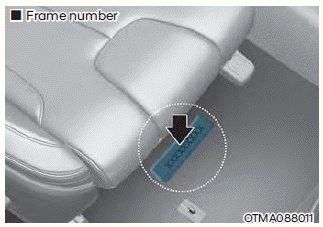Hyundai Santa Fe: Cylinder Head Assembly / CVVT & Camshaft. Repair procedures
Hyundai Santa Fe (TM) 2019-2025 Service Manual / Engine Mechanical System / Cylinder Head Assembly / CVVT & Camshaft. Repair procedures
| Removal |
|
CVVT & Cam Shaft
| 1. |
Remove the timing chain.
(Refer to Timing System - "Timing Chain")
|
| 2. |
Remove the oil control valve (OCV) and center bolt (A).
[Intake oil control valve (OCV) and Center Bolt]
[Exhaust oil control valve (OCV) and Center Bolt]
|
| 3. |
Remove the intake CVVT (A).
|
| 4. |
Remove the exhaust CVVT (A).
|
| 5. |
Remove the camshaft front bearing cap (A) and camshaft bearing caps
(B).
|
| 6. |
Remove the camshaft (A).
[Intake Camshaft]
[Exhaust Camshaft]
|
CVVT & Cam Shaft Assembly
| 1. |
Remove the timing chain.
(Refer to Timing System - "Timing Chain")
|
| 2. |
Remove the camshaft front bearing cap (A) and camshaft bearing caps
(B).
|
| 3. |
Remove the intake camshaft & CVVT assembly (A).
|
| 4. |
Remove the exhaust camshaft & CVVT assembly (A).
|
| Inspection |
Camshaft
| 1. |
Inspect the cam lobes.
Using a micrometer, measure the cam lobe height.
If the cam lobe height is less than standard, replace the camshaft.
|
| 2. |
Inspect the camshaft journal clearance.
|
| 3. |
Inspect the camshaft end play.
|
| Installation |
CVVT & Cam Shaft
| 1. |
Install the camshaft (A).
[Intake Camshaft]
[Exhaust Camshaft]
|
| 2. |
Install the camshaft front bearing cap (A) and camshaft bearing caps
(B).
|
| 3. |
Install the exhaust CVVT (A).
|
| 4. |
Install the intake CVVT (A).
|
| 5. |
Install the oil control valve (OCV) and center bolt (A).
[Intake oil control valve (OCV) and Center Bolt]
[Exhaust oil control valve (OCV) and Center Bolt]
|
| 6. |
Install the timing chain.
(Refer to Timing System - "Timing Chain")
|
CVVT & Cam Shaft Assembly
| 1. |
Install the exhaust camshaft & CVVT assembly (A).
|
| 2. |
Install the intake camshaft & CVVT assembly (A).
|
| 3. |
Install the camshaft front bearing cap (A) and camshaft bearing caps
(B).
|
| 4. |
Install the timing chain.
(Refer to Timing System - "Timing Chain")
|
 CVVT & Camshaft. Description and operation
CVVT & Camshaft. Description and operation
Description
Continuous Variable Valve Timing (CVVT) system advances or retards the valve
timing of the intake and exhaust valve in accordance with the ECM control signal
which is calculated by the engine speed and load...
 Cylinder Head. Repair procedures
Cylinder Head. Repair procedures
Removal
•
Be careful not to damage the parts located under the vehicle
(floor under cover, fuel filter, fuel tank and canister) when
raising the vehicle using the lift...
Other information:
Hyundai Santa Fe (TM) 2019-2025 Service Manual: Crash Pad Side Cover. Repair procedures
Replacement • Put on gloves to prevent hand injuries. • When removing with a flat-tip screwdriver or remover, wrap protective tape around the tools to prevent damage to components...
Hyundai Santa Fe (TM) 2019-2025 Service Manual: Cylinder Head. Repair procedures
Removal • Be careful not to damage the parts located under the vehicle (floor under cover, fuel filter, fuel tank and canister) when raising the vehicle using the lift...
Categories
- Manuals Home
- 4th Generation Santa Fe Owners Manual
- 4th Generation Santa Fe Service Manual
- Troubleshooting
- Brake bleeding procedures
- Side air bags
- New on site
- Most important about car
Vehicle Identification Number (VIN). Vehicle certification label. Tire specification and pressure label
Vehicle Identification Number (VIN)

The vehicle identification number (VIN) is the number used in registering your vehicle and in all legal matters pertaining to its ownership, etc.
The number is punched on the floor under the passenger seat. To check the number, open the cover.
Copyright © 2025 www.hsafe4.com






















